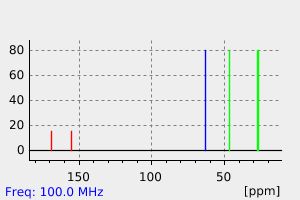四氢-1H,3H-吡咯并[1,2-c]恶唑-1,3-二酮 | 5626-64-2
中文名称
四氢-1H,3H-吡咯并[1,2-c]恶唑-1,3-二酮
中文别名
3-{[2-({N-[(2R)-2,4-二羟基-3,3-二甲基丁酰]-β-丙氨酰}氨基)乙基]硫烷基}-2-羰基丙酸
英文名称
DL-Pro-NCA
英文别名
Tetrahydro-1H,3H-pyrrolo(1,2-c)oxazole-1,3-dione;5,6,7,7a-tetrahydropyrrolo[1,2-c][1,3]oxazole-1,3-dione
CAS
5626-64-2
化学式
C6H7NO3
mdl
——
分子量
141.126
InChiKey
JNWNBXNPBSVNMU-UHFFFAOYSA-N
BEILSTEIN
——
EINECS
——
-
物化性质
-
计算性质
-
ADMET
-
安全信息
-
SDS
-
制备方法与用途
-
上下游信息
-
文献信息
-
表征谱图
-
同类化合物
-
相关功能分类
-
相关结构分类
计算性质
-
辛醇/水分配系数(LogP):0.2
-
重原子数:10
-
可旋转键数:0
-
环数:2.0
-
sp3杂化的碳原子比例:0.67
-
拓扑面积:46.6
-
氢给体数:0
-
氢受体数:3
SDS
反应信息
-
作为反应物:描述:参考文献:名称:Hosten, N.; Antenuis, M.J.O, Bulletin des Societes Chimiques Belges, 1988, vol. 97, # 1, p. 48 - 50摘要:DOI:
-
作为产物:参考文献:名称:Efficient Preparation of Proline N-Carboxyanhydride Using Polymer-Supported Bases摘要:[GRAPHICS]A procedure for the preparation of proline N-carboxyanhydride in high yield and purity is described using polymer-supported tertiary amines. The polymer-supported amine can be recycled with a basic wash and filtration of the resin. The procedure facilitates the access to the efficient preparation of the polyproline polymer with potential therapeutic interest.DOI:10.1021/ol0622965
文献信息
-
Friedel-Crafts α-Aminoacylation of Aromatic Compounds with a Chiral N-Carboxy-α-amino Acid Anhydride (NCA); Part 2作者:Osamu Itoh、Akira AmanoDOI:10.1055/s-1999-3405日期:1999.3The N-carboxy-α-amino acid anhydrides (NCA) derived from L-Asp(OEt), L-Glu(OMe), L-Met, and L-Pro reacted with aromatic compounds (toluene or benzene) in the presence of AlCl3, to afford the corresponding α-aminoalkyl aryl ketones as hydrochloride salts in moderate yields. The β- and γ-amino acid esters, which were obtained from the reaction of the aromatic compounds with L-Asp(OEt)- and L-Glu(OMe)-NCA, were hydrolyzed by hydrochloric acid to the corresponding β- and γ-amino acids as hydrochloride salts. L-Phe-NCA did not react with benzene in the presence of AlCl3, instead an intramolecular acylation occurred to afford (S)-2-aminoindanone hydrochloride. The chiralities of the original L-α-amino acids were most retained during these α-aminoacylation.
-
US5650521A申请人:——公开号:US5650521A公开(公告)日:1997-07-22
表征谱图
-
氢谱1HNMR
-
质谱MS
-
碳谱13CNMR
-
红外IR
-
拉曼Raman
-
峰位数据
-
峰位匹配
-
表征信息
同类化合物
(甲基3-(二甲基氨基)-2-苯基-2H-azirene-2-羧酸乙酯)
(±)-盐酸氯吡格雷
(±)-丙酰肉碱氯化物
(d(CH2)51,Tyr(Me)2,Arg8)-血管加压素
(S)-(+)-α-氨基-4-羧基-2-甲基苯乙酸
(S)-阿拉考特盐酸盐
(S)-赖诺普利-d5钠
(S)-2-氨基-5-氧代己酸,氢溴酸盐
(S)-2-[[[(1R,2R)-2-[[[3,5-双(叔丁基)-2-羟基苯基]亚甲基]氨基]环己基]硫脲基]-N-苄基-N,3,3-三甲基丁酰胺
(S)-2-[3-[(1R,2R)-2-(二丙基氨基)环己基]硫脲基]-N-异丙基-3,3-二甲基丁酰胺
(S)-1-(4-氨基氧基乙酰胺基苄基)乙二胺四乙酸
(S)-1-[N-[3-苯基-1-[(苯基甲氧基)羰基]丙基]-L-丙氨酰基]-L-脯氨酸
(R)-乙基N-甲酰基-N-(1-苯乙基)甘氨酸
(R)-丙酰肉碱-d3氯化物
(R)-4-N-Cbz-哌嗪-2-甲酸甲酯
(R)-3-氨基-2-苄基丙酸盐酸盐
(R)-1-(3-溴-2-甲基-1-氧丙基)-L-脯氨酸
(N-[(苄氧基)羰基]丙氨酰-N〜5〜-(diaminomethylidene)鸟氨酸)
(6-氯-2-吲哚基甲基)乙酰氨基丙二酸二乙酯
(4R)-N-亚硝基噻唑烷-4-羧酸
(3R)-1-噻-4-氮杂螺[4.4]壬烷-3-羧酸
(3-硝基-1H-1,2,4-三唑-1-基)乙酸乙酯
(2S,4R)-Boc-4-环己基-吡咯烷-2-羧酸
(2S,3S,5S)-2-氨基-3-羟基-1,6-二苯己烷-5-N-氨基甲酰基-L-缬氨酸
(2S,3S)-3-((S)-1-((1-(4-氟苯基)-1H-1,2,3-三唑-4-基)-甲基氨基)-1-氧-3-(噻唑-4-基)丙-2-基氨基甲酰基)-环氧乙烷-2-羧酸
(2S)-2,6-二氨基-N-[4-(5-氟-1,3-苯并噻唑-2-基)-2-甲基苯基]己酰胺二盐酸盐
(2S)-2-氨基-N,3,3-三甲基-N-(苯甲基)丁酰胺
(2S)-2-氨基-3-甲基-N-2-吡啶基丁酰胺
(2S)-2-氨基-3,3-二甲基-N-(苯基甲基)丁酰胺,
(2S)-2-氨基-3,3-二甲基-N-2-吡啶基丁酰胺
(2S,4R)-1-((S)-2-氨基-3,3-二甲基丁酰基)-4-羟基-N-(4-(4-甲基噻唑-5-基)苄基)吡咯烷-2-甲酰胺盐酸盐
(2R,3'S)苯那普利叔丁基酯d5
(2R)-2-氨基-3,3-二甲基-N-(苯甲基)丁酰胺
(2-氯丙烯基)草酰氯
(1S,3S,5S)-2-Boc-2-氮杂双环[3.1.0]己烷-3-羧酸
(1R,5R,6R)-5-(1-乙基丙氧基)-7-氧杂双环[4.1.0]庚-3-烯-3-羧酸乙基酯
(1R,4R,5S,6R)-4-氨基-2-氧杂双环[3.1.0]己烷-4,6-二羧酸
齐特巴坦
齐德巴坦钠盐
齐墩果-12-烯-28-酸,2,3-二羟基-,苯基甲基酯,(2a,3a)-
齐墩果-12-烯-28-酸,2,3-二羟基-,羧基甲基酯,(2a,3b)-(9CI)
黄酮-8-乙酸二甲氨基乙基酯
黄荧菌素
黄体生成激素释放激素(1-6)
黄体生成激素释放激素 (1-5) 酰肼
黄体瑞林
麦醇溶蛋白
麦角硫因
麦芽聚糖六乙酸酯
麦根酸







